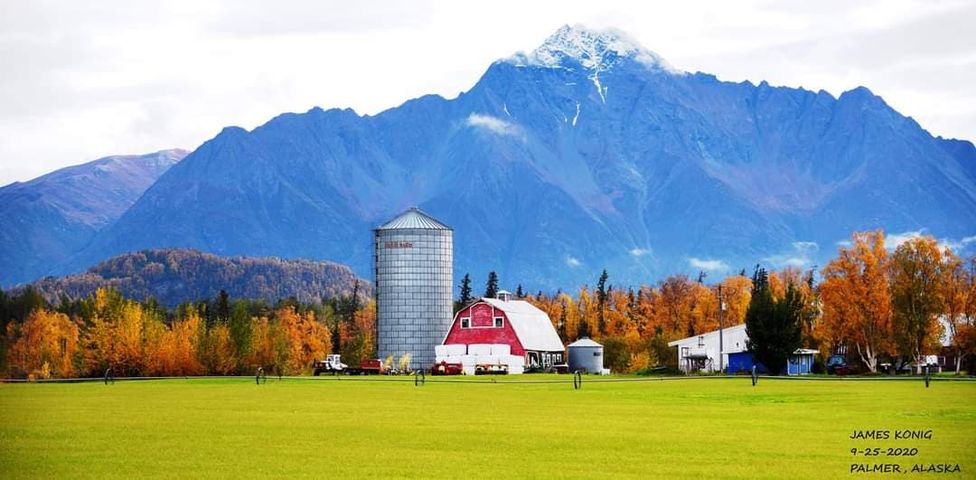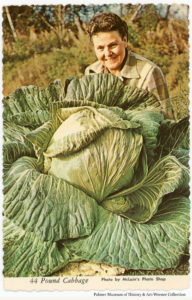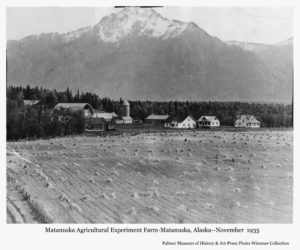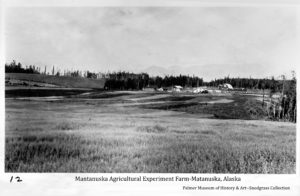Article by Jodie Anderson
Farming in Alaska may conjure images of planting seeds in snow. In reality farming is lush and a bit ridiculous. A green cabbage weighing in at 138.25 pounds in 2012. A beet tipping the scales at 42.75 pounds in 1999. A turnip topping off at 39.20 pounds in 2004. What do these giant vegetables all have in common aside from setting a world record in their respective years? They were all grown in the rich, silt loam soils of the Matanuska Valley in Palmer, Alaska. In addition to the great soils these plants also receive over 19 hours of daylight during the peak of the growing season that doesn’t hurt either.
A Brief History of Farming in Alaska starting in the Matanuska Valley
The Matanuska Valley became the land of giant vegetables only after the federal government started building a railroad through it in 1915. M. D. Snodgrass, settlement agent for the Alaska Railroad, had the vision to recommend placing an agricultural experiment station at the crossroads of the Anchorage-Fairbanks line and the coal line from Anchorage-Sutton through now downtown Palmer in 1917. Work began on the 880 acres Matanuska Experiment Station, and by August of that year the Superintendent’s house, one of the first houses in the Matanuska Valley to be built with dimensional lumber, was completed.
The farm played a key role in the development of agricultural activity and research in the Matanuska-Susitna area, especially in the development of over 100 crop varieties specifically bred for Alaska conditions. Since 2010, the emphasis has shifted from research to public outreach. The Matanuska Experiment Station was renamed the Matanuska Experiment Farm and Extension Center in 2014 when the Mat-Su/Copper River Cooperative Extension District moved to the Matanuska Experiment Farm.
The creation of the Matanuska Experiment Station in 1917 brought more than agricultural research to the Matanuska Valley: it drew the attention of federal emergency relief money to the Valley after the Great Depression. The Matanuska Colony project saw 203 disadvantaged families from Michigan, Minnesota, and Wisconsin transplanted to Palmer, Alaska to develop a self-sufficient general farm on at least 40 acres. In May, 1935, the colonists arrived in Palmer to begin their new lives in Alaska. At the end of 1948, nearly one-third of the original colonists still lived in the Matanuska-Susitna Valley area.
The Matanuska Valley Today: the vegetables growing region of the state
So, what does agriculture look like in the Matanuska Valley today? In this area, vegetable production is happening at all levels of scale: from family-sized gardens, 1-2 acre plots for organic and conventional truck gardening, and commercial farming of 100s of acres. There are livestock farms ranging from the common animals one finds on many farms to the more unique like elk, yak, bison, and reindeer. The Matanuska Valley is home to the only Grade A cow dairy as well as producing much of the state’s potatoes and vegetables, oats, hay, greenhouse plants and vegetables, and sod. You can find many of the larger vegetable, cut flower, and hay farms south of Palmer on the Springer Road system as well as in the Bodenburg Loop area of the Butte southeast of Palmer, livestock farms east of Palmer on Lazy Mountain, the dairy west of Palmer off Bogard Road, an edible trail known as Grow Palmer in downtown Palmer on the rail trail north of the Depot, and family/community gardens all over the Matanuska Valley.
Visiting these Historic Farms and Vegetables
The story and unique setting of agriculture in Alaska draws much attention from many of our visitors every summertime. This has created an opportunity for a new facet of the Alaska tourism industry: agrotourism. There are now farms and companies that will take you on guided tours of farms or give the visitor a chance to stay on the farms. If you come at the right time of year and are able to get on a farm tour or two, you may be able to see some of those amazing vegetables.
If you are looking for on farm tours consider visiting the Reindeer Farm, or the Musk Ox Farm, booking a tour with Alaska Farm Tours, or visiting Pyrah’s U-Pick Farm.
 About the author: This is Jodie Anderson and she is the Director of the University of Alaska Fairbanks (UAF) Matanuska Experiment Farm and Extension Center since August 2018. Her family moved up to Palmer in 2003 and she worked for the University of Alaska Fairbanks where she nearly completed a PhD in soil biochemistry. While at UAF, she began and managed the Alaska Community Horticulture Program as well as research that focused on soil building, organic nitrogen soil supplements, compost development, and community gardening. She pushes hard every day to continue the great work Alaska expects from the Matanuska Experiment Farm and Extension Center.
About the author: This is Jodie Anderson and she is the Director of the University of Alaska Fairbanks (UAF) Matanuska Experiment Farm and Extension Center since August 2018. Her family moved up to Palmer in 2003 and she worked for the University of Alaska Fairbanks where she nearly completed a PhD in soil biochemistry. While at UAF, she began and managed the Alaska Community Horticulture Program as well as research that focused on soil building, organic nitrogen soil supplements, compost development, and community gardening. She pushes hard every day to continue the great work Alaska expects from the Matanuska Experiment Farm and Extension Center.




